I’m happy to announce a new training plan here on Training4cyclists.com. A bike training plan was developed for road cyclists with ambitions to ride a little faster.
This training plan will improve your performance within six weeks. It will be a challenging training plan, so don’t enter it if you feel unsure. It’s a demanding training plan, but not impossible.
The 6-week training plan aims to increase your chances of completing the training plan as intended.
Please bookmark this training plan:
https://www.training4cyclists.com/6-week-training-plan/
Week 1: Tiny increments in training volume
Week 2: Sub-threshold intervals for aerobic performance
Week 3: Add more training volume
Week 4: Keep the momentum
Week 5: Reaching a new level
Week 6: New training routine
Week 1 – Tiny increments in training volume
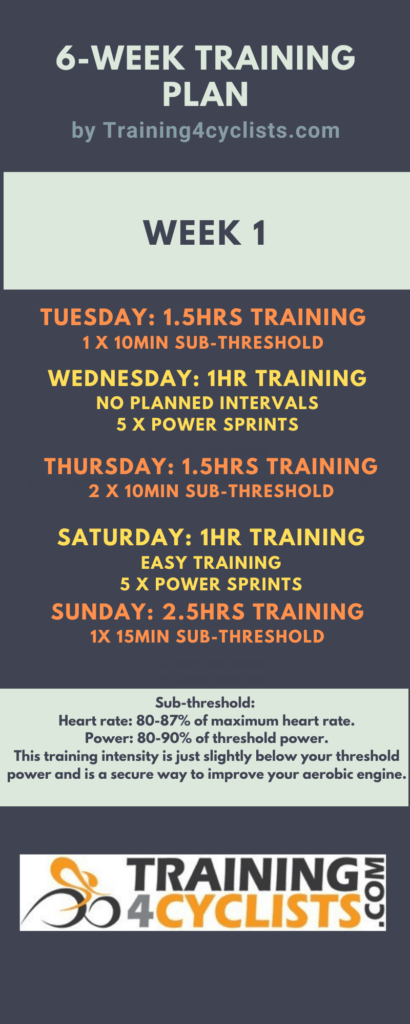
The 6-Week Training Plan is for riders who train on avg—7hrs per week. The goal is to increase your training volume over the next six weeks. Small increments in training volume each week will significantly improve performance when added together. These increments are almost invisible, and you won’t notice anything during the first two to three weeks. But these increments work as you add more depth to your training volume.
When your weekly training volume increases, you’ll reach a higher level of aerobic performance, and you will increase fat loss. As mentioned before, adding more hours is one of the most effective methods to improve cycling performance.
This training plan will make you faster and fitter and ultimately increase your chances of winning a cycling race.
If you train less than 7 hrs/week, you should adjust your training volume accordingly. Training sessions in orange are the most critical parts of this training plan. You can remove training sessions written in yellow if you need to reduce total training time.
If you train more than 7 hrs/week, you should add more hours to the training plan. For example, in week 1, you can add more daily volume.
If you are used to a training volume of more than 12+ hrs/week, the 6-week training plan might help you. Still, I would suggest a more specific training plan based on your current fitness and ambitions (increase functional threshold power, lower body fat percentage, etc.) Also, if you have a significant training volume, you should consider implementing some periodization (recovery weeks, etc.).
Intervals based on performance test
Before entering this training plan, you’ll need to estimate or measure your current power output at threshold power. You can do this with a 30-minute performance test where your average power is for practical purposes, and this 30min performance test might at least, in theory, overestimate your ‘functional threshold power.’
However, from a practical point of view, a 30-min test is a secure and proven method to calculate intervals. It might be necessary to adjust your pace slightly during the performance test, but that’s how performance tests are. Also, remember that a 30-min performance test is a great training session in itself.
You can find more information about training intensities here.
Example, Thursday week 1:
1.5 hours – 2 x 10min Sub-threshold20min warm-up (start slowly and work your heart rate up in small steps to about 80%)
10min Sub-threshold (80-87% of maximum heart rate / 80-90% of threshold power)
5 to 10min recovery ( <65% of maximum heart rate / <55% of threshold power). If you need more recovery time for any reason, no problem.
10min Sub-threshold (80-87% of maximum heart rate / 80-90% of threshold power)
30min Endurance training (65-80% of maximum heart rate / 55-80% of threshold power)
10min cool down (<65% of maximum heart rate / <55% of threshold power)
Sub-threshold intervals are a safe and excellent method to develop a solid aerobic engine. Because they are performed at an intensity safely below threshold power, you can perform impressive amounts of these without overshooting.
Also, there is no reason to stress the length of recovery between intervals too much. Most often, 5 to 10 minutes would be fine, but you will also achieve great results with shorter or more prolonged recovery.
I have defined sub-threshold intensity as 80 to 87% of your maximum heart rate indicating that you can make these intervals relatively easy and tricky. There is room for a personal fitting, and there is quite a difference between 80 and 87% of the maximum heart rate.
Some days you will appreciate a light 80% workout, and some days, you will push yourself to the limit with an 87% workout.
Use your best judgment to decide the right intensity.
If you use a power meter as a pacing tool, I suggest aiming for 80 to 90% of threshold power during sub-threshold intervals. But, again, it is worth remembering that there is a significant difference between 80 and 90 %.
It is clear that pacing with a power meter is much easier, but in most cases, it is possible to learn how to get the right pace for threshold intervals using a heart rate monitor or simply your gut feeling. Experienced riders know how to pace themselves in sub-threshold intervals because they have performed tons of them.
However, in the end, it is up to you to decide how hard you want to push yourself through these intervals.
Week 2 – Sub-threshold intervals for aerobic performance
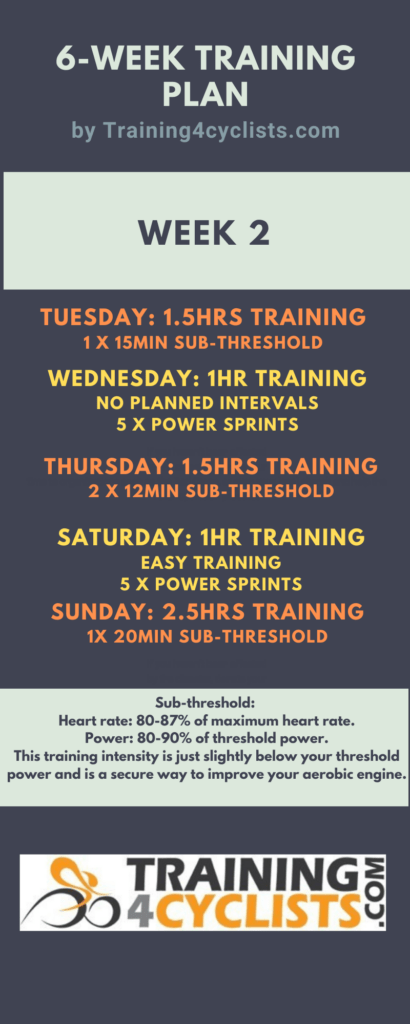
Adding more hours to your training volume is a secure way to improve performance. However, if you want to benefit from the tiny increments in week 1, you’ll have to do at least the same in week 2. The magic from these minor adjustments to your weekly workload will only happen if you do your best to push a little more complicated.
In week 2, there are also minor sub-threshold interval volume adjustments. Generally, I believe sub-threshold intervals should be an integral part of any serious training plan. However, if you want to build aerobic endurance, it isn’t easy to find reasons not to use sub-threshold intervals once in a while.
When you train at this relatively safe intensity, slightly lower than threshold power, you can work for a longer time with minimal anaerobic metabolism. It is excellent for your chances to reach better performance because you can perform impressive amounts of these intervals without overshooting.
Thus, riding sub-threshold intervals will improve your aerobic performance but have almost no impact on your anaerobic endurance and minimal impact on your recovery time.
Week 3 – Add more training volume
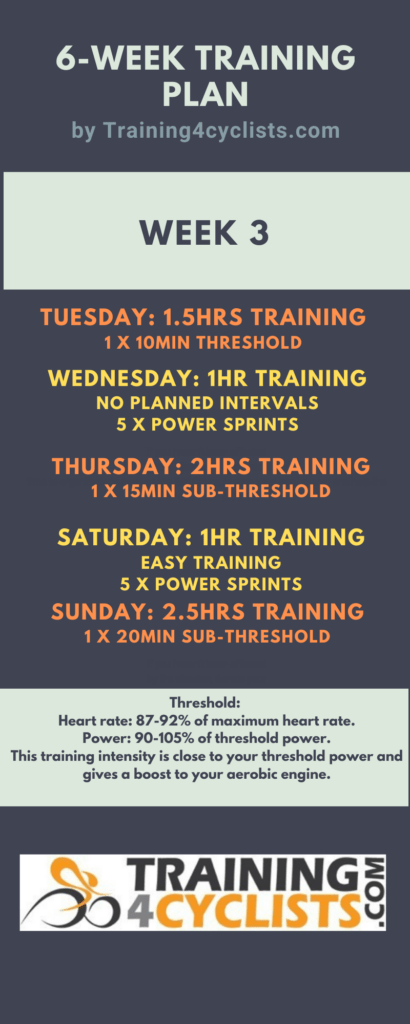
This 6-week training plan aims to increase your training volume from 7 to 9 hours per week. By making this increment in small steps, there is a better chance that you will succeed. Therefore, the goal for week 3 is to reach a total training volume of 8hrs. Adding more hours to your training volume is key to success with this training program. These marginal increments will add up.
As always, interval training days have the highest priority. Of course, it is possible to switch training days if necessary, but I suggest you have at least one day off or an easy training session between the three ‘orange’ training days.
In week 3, there is a new interval session: threshold power intervals. These intervals are, by definition, significantly more challenging than sub-threshold intervals, but they will also have a more profound impact on your progress.
What are power sprints?
A power sprint is my little input to your neural system because they are great for making neural adaptations. From a shallow speed (0 to 5 km/hr), you should make a very explosive acceleration for about 10 seconds. Use gear ratio 53 / 14-17 teeth.
You can make both seated and standing sprints. You are allowed to use your upper body as well as your legs. You will need a full recovery (at least 5 min) before every power sprint.
By making these power sprints twice a week, you’ll become more robust and make powerful launches of attacks and sprints. Also, there might be a minor benefit for your endurance as well.
Week 4 – Keep Momentum
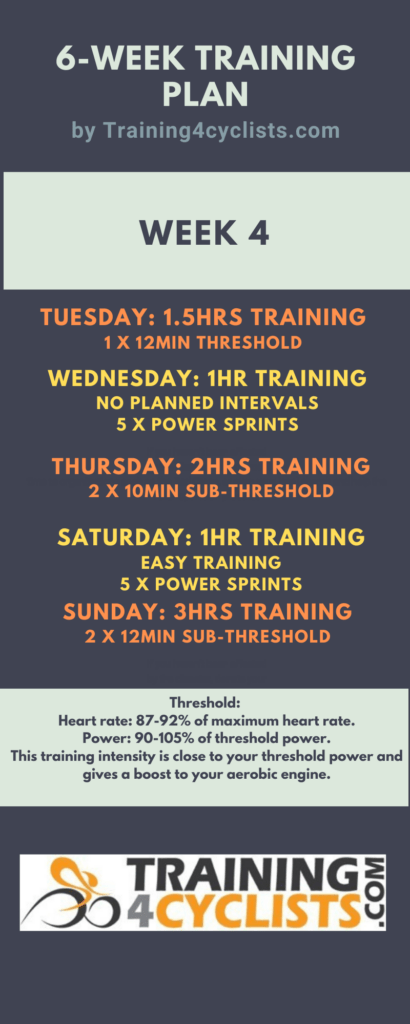
It takes time to adapt to new training routines, but this 6-week training plan makes minor tweaks to your current training volume that is almost invisible. However, over time your body will notice an increased need for recovery. Therefore, you must keep momentum and use your motivation to pay more attention to your diet. Weight loss is not a focus point, but you must give your body the best fuel for serious cycling training.
Week 5 – Reaching a new level
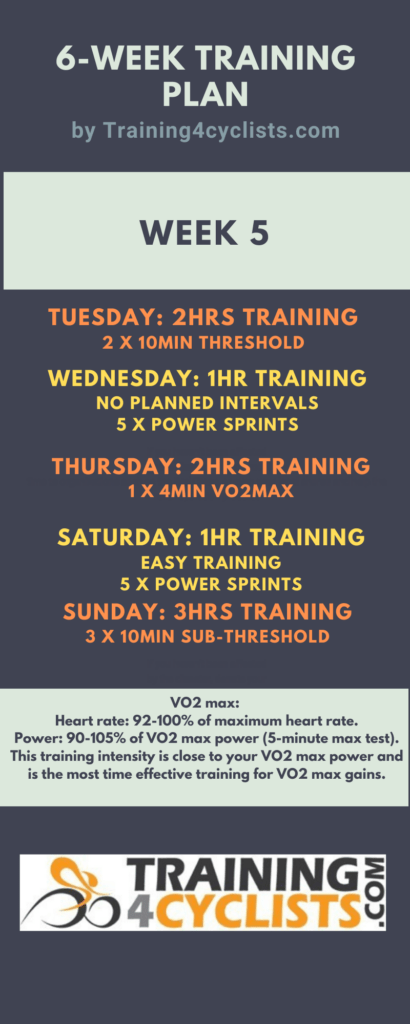
First, adapting to your new training volume is essential before implementing too many interval training sessions and cycling races. It is possible to increase both training volume and intensity simultaneously, but there is also a greater risk of overshooting. Still, adding small VO2 max sessions will be good for your progress, so I suggest implementing some VO2 max training in week 5. It is also critical to fully acclimatize to a higher training volume.
Week 6 – New Routine
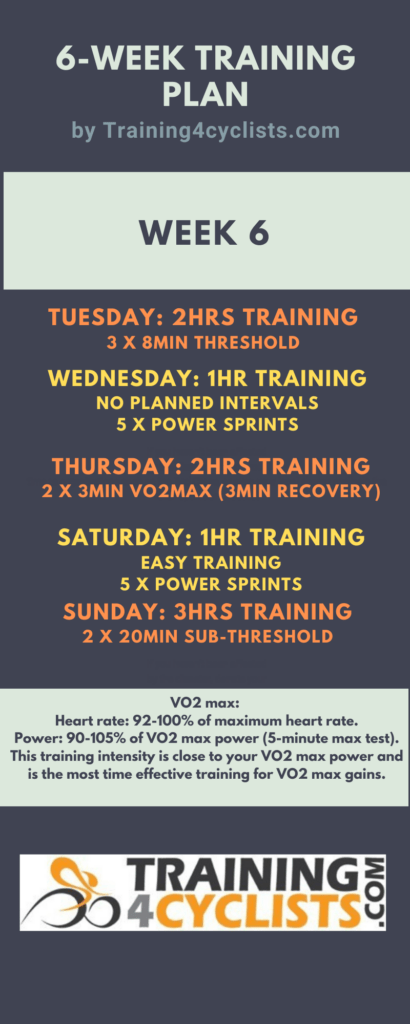
In the final week, you’ll manage a total training volume of 9 hrs, including both power sprints, sub-threshold power intervals, threshold power intervals, VO2 max training, and endurance rides of more than 3hrs.
Depending on your ambitions, you could take a few easy training days after week 6, and then I expect you to be significantly more robust than before entering this training plan. The next step could be implementing principles from the pre-season training strategies suggested here.
This training plan incorporates a variety of different types of training to improve cycling performance. By gradually increasing intensity over time and combining different types of workouts, cyclists can see improvements in endurance, power, speed, and overall fitness.
If you like this training plan, feel free to share this link with your friends:
https://www.training4cyclists.com/6-week-training-plan/


Hello Jesper,
nice that there is a new plan.
Show us the last 5 weeks 🙂
Thank you for your commitment
Regards
Sven
Hi Sven
The complete 6-week training plan is available now. Enjoy!
Kind regards,
Jesper